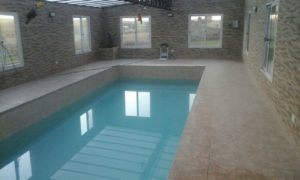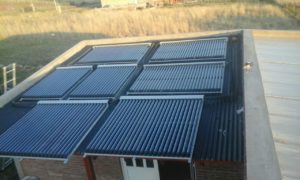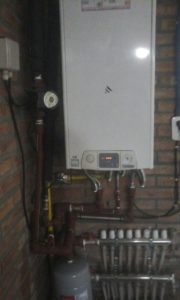Sorry, this entry is only available in Español.
Category Archives: Solar Thermal Energy
Passive Solar Energy
One of the most important issues in energy conservation areas and solar energy use is undoubtedly homes and workplaces air conditioning application.
This sector accounts about 40% of the total energy consumed. The savings can be achieved by using solar energy for heating is of the order of 60% to 80% depending on house design.
The principles of bioclimatic architecture should be applied in all new urban plans.
When speaking of passive solar architecture, we talk about modeling, selection and use of passive solar technology, which is capable of maintaining a comfortable and pleasant temperature home environment through the sun. This type of architecture is only a small part of the energy efficient buildings design and is considered as part of sustainable design.

There are three types of solar gain:
1) Direct solar gain: refers to the use of windows, skylights and blinds to control the amount of solar radiation reaching the inside of a housing, in combination with mass floors.
2) Indirect solar gain: is achieved through the skin of the building, designed with certain thermal mass. An example of this gain is also the garden roof.
3) Isolated solar gain: is the process in which the main thing is the sun heat passive capture, and then transport it inside or outside the home.
There are considerations to take into account in this type of architecture implementation, to give his best result:
* Building orientation
* Construction features
* Environment use

In existing buildings we can always intervene to improve thermal insulation, sun blinds open in winter or adding a glass gallery on the north side of the house if we are located in the southern hemisphere.
To heat the house with the sun, a clear winter north facade without many neighbors who clog the midday sun is needed.
Main glazings must be on the north facade. For example, if we are located in the southern half of Argentina we need 1.4 to 2 m2 of north glass for every 10 m2 stay we want to heat.
Windows should be closed with curtains or blinds at night to heat captured not escape. It is good to improve thermal insulation as far as possible and have thermal mass (building material in walls, floors) which accumulate the heat of the day to the night. For summer it is necessary to place eaves, awnings, vines, etc. that shade windows in.
You can acces more Spanish language content like this in Manual Técnico – Comercial de Energía Solar Térmica by Sopelia.
What is the best solar collector?
What qualities should we consider when selecting a solar thermal collector?
Are two:
1- Its constructive qualities. Determines the durability and architectural integration possibility.
2- His energetic qualities. Determines economic performance.
In some respects both qualities are interrelated.
A good solar collector is one who possesses both qualities well balanced for the intended application.

There is no use a solar collector with an extraordinary energy intake if their constructive qualities fail or degrade quickly, since the profitability of these facilities is measured in the medium term.
There is no use a solar collector with extraordinary constructive qualities if their energetic qualities fail, because, simply, it is not fulfilling its main task.
By observing the solar collector performance curve, we see that it depends on a variable which is the temperature T, which in turn depends on the solar radiation I, on solar collector fluid inlet temperature Te and on ambient temperature Ta.
That is, the performance of a collector depends:
– On one side of the weather conditions, given by I and Ta,
– On the other side of the working conditions, that is, of what it is used, given by Te.
Therefore, when selecting a collector must be considered:
1) The application will have (only ACS, only heating, hot water and heating, pool heating, etc.).
2) Climatic and radiation conditions of facility location.
3) Models performance curves.
4) Equipment price.
5) The economic profitability (based purely on the relationship between price and yield) and investment recovery period.
6) Its construction quality.
You need to balance construction quality with energetic quality.

There is an open debate among professionals about which of the two most used collectors technologies is the most appropriate: flat or vacuum tube collector?
Those who opt for vacuum tube collectors consider them more advanced and argue that in the future this technology will eventually displace definitely flat plate collectors because of their better performance.
The increased cost gap of vacuum tube collectors respect to flat collectors has been reduced and we can find collectors of both technologies at the same price.
Supporters of the vacuum tube collectors consider opting for them is compensated, because by offering higher performance per m2 we will need to purchase less collectors.
This is not necessarily true, especially in small facilities:
In a small facility that only provides ACS with good weather and radiation conditions, flat plate collectors performance and profitability will be greater.
As you increase the size of the installation, the vacuum tube collector highest performance will offset the lower absorbing surface.
We will also consider building integration of vacuum tubes direct flow collectors (U-Pipe) that can be placed vertically covering a façade or balcony.

In short, a properly trained professional must assess based on the following factors choosing one or the other technology:
• Specific requirements of the installation
• Location climatology in every season
• Previous experience
• Budget availability.
You can find content like this in the Technical – Commercial Solar Thermal Energy Manual by Sopelia
Solar Creativity
When Federico Redin answered the phone call at his office in Bahia Blanca (Argentina) he was happy because it was to request their installation services in a new solar energy project.
But when he came to the house where the project would be located, he realized that the facility had some complexity.
It was a continuous use indoor pool with bathroom, dressing room and kitchen.
The pool was closed with rustic solid brick walls, aluminum DVH low quality openings in the enclosure and transparent polycarbonate roof. A challenge.

After the visit, which solution adopt to optimally configure the installation was going around in his head.
Appealing to the characteristic creativity of Argentine people, Federico took an unconventional solution: swimming pool conditioning by floor heating (in the transit zones of the enclosure and in the pool itself).
In this way it would achieve heat the pool regardless of the type of water containing the glass and more efficiently, since conventional pool heating has the negative inertia of moving water.
By heating the pool water with a conventional boiler the water is set into motion with the same pool pump, causing cooling it by this movement; which decreases the overall installation performance.
Therefore, a more powerful source of energy and more thermal reaction is needed.
We know that using solar energy do not have a large thermal reaction, ie the heating time is slower.
By heating the pool with underfloor heating water turns hot through the concrete, once in regime, it has more thermal inertia and allows solar energy to maintain that regime.
The radiant “glass” pool and the transit floor area of the enclosure receive input from a conventional gas boiler, which is responsible for putting installation in system, and 7 heat pipe collectors supplying directly fluid to the circuit (without heat exchanger) that transfers heat in sunshine.

Temperature is regulated with a mixing thermostatic valve to not degrade the soil at high temperatures.
The system has a thermostat for transit zones and a thermostat for swimming pool water.
Then room or water temperature are discriminated with electric heads located at the underfloor heating collector, separating pool and transit zones of the enclosure.
The pool has a natural salt chlorination system (salt water 5%) thus avoiding the use of chlorine.

Having 2 separate circuits (the pool and underfloor heating), we protect the boiler to heat salt water, which quickly will cause severe and irreversible damage to it.
Federico Redin is Sopelia facilities expert advisor.
Solar Thermal Latin America
Solar thermal energy for domestic applications is a mature technology that has been successfully developed in many countries for over 30 years.
It is not well understood why its underdeveloped compared with photovoltaics while almost double its performance.
It is a relatively simple technology that already has small and medium manufacturers in countries of the region such as Argentina, Uruguay and Brazil. However, there is still no certification at regional level as in Europe.
In the Caribbean nation of Barbados 80% – 90% of households have solar energy equipment on their roofs. This country ranks in the top 5 global installed capacity per capita.
There are no reliable data concerning the installed capacity in Latin America.
The most recent global estimate dating from 2012 and informs an installed capacity of 234 GWth. Brazil is among the top 7 countries with about 4 GWth (2%).

The Latin American regional market is slowly developing.
In parallel, there is an emerging incipient regulatory framework for certifications that are mainly based on regulatory frameworks of Europe and the US. COPANT is working on the unification of the regional framework of standards and certifications.
One of the main barriers to the development of solar thermal energy are important subsidies that some countries in the region granted to conventional energy.
Professionals and companies in the solar energy industry of Latin America and the Caribbean met recently in San Jose, Costa Rica, to promote the development of this technology in the region.
The meeting was made by IRENA (International Renewable Energy Agency), OLADE (Latin American Energy Organization), ICE (Instituto Costarricense de Electricidad) and the German Metrology Institute (PTB).
According to the Innovation and Technology Department of IRENA, currently the region only takes advantage of 3% of its solar thermal potential.
The most important conclusión we arrived is that the region has great potential for development of solar energy in residential and commercial areas, but experience shows that to achieve this, we must build confidence in this technology.
How is this achieved ?
Proposals were:
1) Develop mechanisms to ensure the quality of the facilities (standards and inspections)
2) Encourage best practices among professionals and companies (testing and certification)
3) Implement government policies that promote genuine development of this technology

The global analysis of the development programs of solar thermal energy estimates a worldwide installed capacity of 1,600 GWth in 2030 and 3,500 in 2050 GWth.
Will be Latin America an important player in this global installed capacity growing ?
To know that, in next deliveries we will discuss solar thermal sector of each country in the region.
